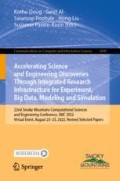Abstract
The operation of the neutron facility relies heavily on beamline scientists. Some experiments can take one or two days with experts making decisions along the way. Leveraging the computing power of HPC platforms and AI advances in image analyses, here we demonstrate an autonomous workflow for the single-crystal neutron diffraction experiments. The workflow consists of three components: an inference service that provides real-time AI segmentation on the image stream from the experiments conducted at the neutron facility, a continuous integration service that launches distributed training jobs on Summit to update the AI model on newly collected images, and a frontend web service to display the AI tagged images to the expert. Ultimately, the feedback can be directly fed to the equipment at the edge in deciding the next-step experiment without requiring an expert in the loop. With the analyses of the requirements and benchmarks of the performance for each component, this effort serves as the first step toward an autonomous workflow for real-time experiment steering at ORNL neutron facilities.
This manuscript has been co-authored by UT-Battelle, LLC, under contract DE-AC05-00OR22725 with the US Department of Energy (DOE). The US government retains and the publisher, by accepting the article for publication, acknowledges that the US government retains a nonexclusive, paid-up, irrevocable, worldwide license to publish or reproduce the published form of this manuscript, or allow others to do so, for US government purposes. DOE will provide public access to these results of federally sponsored research in accordance with the DOE Public Access Plan (http://energy.gov/downloads/doe-public-access-plan).
Access this chapter
Tax calculation will be finalised at checkout
Purchases are for personal use only
References
DeCost, B., Hattrick-Simpers, J., Trautt, Z., Kusne, A., Campo, E., Green, M.: Scientific AI in materials science: a path to a sustainable and scalable paradigm. Mach. Learn. Sci. Technol. 1(3), 033001 (2020). https://doi.org/10.1088/2632-2153/ab9a20
Stach, E., et al.: Autonomous experimentation systems for materials development: a community perspective. Matter 4(9), 2702–2726 (2021). https://www.osti.gov/biblio/1823639
Cao, H., et al.: DEMAND, a dimensional extreme magnetic neutron diffractometer at the high flux isotope reactor. Crystals 9(1), 5 (2019). https://www.mdpi.com/2073-4352/9/1/5
Arnold, O., et al.: Mantid-data analysis and visualization package for neutron scattering and SR experiments. Nucl. Instrum. Methods Phys. Res. Sect. A 764, 156–166 (2014). http://www.sciencedirect.com/science/article/pii/S0168900214008729
Minaee, S., Boykov, Y., Porikli, F., Plaza, A., Kehtarnavaz, N., Terzopoulos, D.: Image segmentation using deep learning: a survey. IEEE Trans. Pattern Anal. Mach. Intell. 44(7), 3523–3542 (2022)
Long, J., Shelhamer, E., Darrell, T.: Fully convolutional networks for semantic segmentation. CoRR abs/1411.4038 (2014). http://arxiv.org/abs/1411.4038
Ronneberger, O., Fischer, P., Brox, T.: U-net: convolutional networks for biomedical image segmentation. CoRR abs/1505.04597 (2015). http://arxiv.org/abs/1505.04597
Jégou, S., Drozdzal, M., Vázquez, D., Romero, A., Bengio, Y.: The one hundred layers tiramisu: fully convolutional densenets for semantic segmentation. CoRR abs/1611.09326 (2016). http://arxiv.org/abs/1611.09326
Chen, L., Papandreou, G., Kokkinos, I., Murphy, K., Yuille, A.L.: Deeplab: semantic image segmentation with deep convolutional nets, atrous convolution, and fully connected CRFs. CoRR abs/1606.00915 (2016). http://arxiv.org/abs/1606.00915
Pinheiro, P.H.O., Collobert, R., Dollár, P.: Learning to segment object candidates. CoRR abs/1506.06204 (2015). http://arxiv.org/abs/1506.06204
He, K., Gkioxari, G., Dollár, P., Girshick, R.B.: Mask R-CNN. CoRR abs/1703.06870 (2017). http://arxiv.org/abs/1703.06870
Kirillov, A., He, K., Girshick, R.B., Rother, C., Dollár, P.: Panoptic segmentation. CoRR abs/1801.00868 (2018). http://arxiv.org/abs/1801.00868
Hoefler, T., Alistarh, D., Ben-Nun, T., Dryden, N., Peste, A.: Sparsity in deep learning: pruning and growth for efficient inference and training in neural networks. CoRR abs/2102.00554 (2021). https://arxiv.org/abs/2102.00554
Hinton, G., Vinyals, O., Dean, J.: Distilling the knowledge in a neural network (2015). https://arxiv.org/abs/1503.02531
Pasini, M.L., Yin, J., Li, Y.W., Eisenbach, M.: A greedy constructive algorithm for the optimization of neural network architectures. CoRR abs/1909.03306 (2019). http://arxiv.org/abs/1909.03306
Zaharia, M., et al.: Apache spark: a unified engine for big data processing. Commun. ACM 59(11), 56–65 (2016). https://doi.org/10.1145/2934664
Apache kafka. https://kafka.apache.org/. Accessed 06 June 2022
Redis. https://redis.io/. Accessed 06 June 2022
Dash, S., Yin, J., Shankar, M., Wang, F., Feng, W.C.: Mitigating catastrophic forgetting in deep learning in a streaming setting using historical summary. In: 2021 7th International Workshop on Data Analysis and Reduction for Big Scientific Data (DRBSD-7), pp. 11–18 (2021)
Abdulla, W.: Mask R-CNN for object detection and instance segmentation on Keras and tensorflow (2017). https://github.com/matterport/Mask_RCNN
Mcclure, J., et al.: Toward real-time analysis of synchrotron micro-tomography data: accelerating experimental workflows with AI and HPC 1315 (2020). https://www.osti.gov/biblio/1855697
Redisedge. https://redis.com/redis-enterprise/more/redis-edge/. https://github.com/RedisGears/EdgeRealtimeVideoAnalytics. Accessed 06 June 2022
Grafana. https://grafana.com/. Accessed 06 June 2022
Prometheus. https://prometheus.io/. Accessed 06 June 2022
Flask. https://flask.palletsprojects.com. Accessed 06 June 2022
Acknowledgment
This manuscript has been authored by UT-Battelle, LLC under Contract No. DE-AC05-00OR22725 with the U.S. Department of Energy. This neutron data used resources at the High Flux Isotope Reactor, the DOE Office of Science User Facility operated by ORNL.
Author information
Authors and Affiliations
Corresponding author
Editor information
Editors and Affiliations
Rights and permissions
Copyright information
© 2022 The Author(s), under exclusive license to Springer Nature Switzerland AG
About this paper
Cite this paper
Yin, J., Zhang, G., Cao, H., Dash, S., Chakoumakos, B.C., Wang, F. (2022). Toward an Autonomous Workflow for Single Crystal Neutron Diffraction. In: Doug, K., Al, G., Pophale, S., Liu, H., Parete-Koon, S. (eds) Accelerating Science and Engineering Discoveries Through Integrated Research Infrastructure for Experiment, Big Data, Modeling and Simulation. SMC 2022. Communications in Computer and Information Science, vol 1690. Springer, Cham. https://doi.org/10.1007/978-3-031-23606-8_15
Download citation
DOI: https://doi.org/10.1007/978-3-031-23606-8_15
Published:
Publisher Name: Springer, Cham
Print ISBN: 978-3-031-23605-1
Online ISBN: 978-3-031-23606-8
eBook Packages: Computer ScienceComputer Science (R0)

